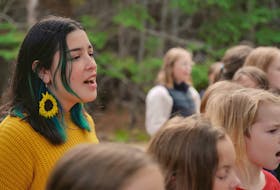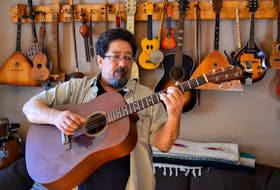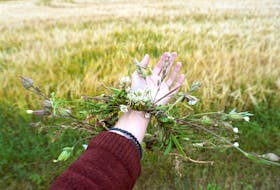In 1755, near Falmouth, three villages of Landry family members hugged the shoreline of the Avon River.
Today, only traces remain, but those remnants can tell much about the past.
“The Sainte-Famille Parish cemetery is so meaningful to me today,” says Hants Border resident Janet Landry. “It is a peaceful, yet haunting, reminder of the Acadian expulsion.
“As a descendent, I care about and visit the Sainte-Famille Cemetery where a brick lies in memory of my Acadian grandmother, Sophie Landry,” she added.
In 1996, the location of the cemetery for the paroisse de Sainte-Famille de Pisiquid was accidentally discovered on Gabriel Road in Falmouth during excavations for a subdivision. After finding bones in the soil, David Christianson of the Nova Scotia Museum was called in. He found a couple of skeletons and more than two dozen graves.
Clay caps about a foot under the surface identified the graves. The graves themselves were five feet deeper. Wrought-iron square nails and fragments of wood dated the graves to the 18th century. A King George III halfpenny and ceramic button from the 1700s were also found.
The discovery placed the area, estimated to contain more than 300 graves, under Nova Scotia’s Special Places Protection Act.
Among the remains that were disinterred were fragments of a child’s skull. Forensic archeologist Talva Jacobson has determined the child, whom she believes was a boy, was between six and nine years of age.
The former Baxter’s Harbour resident and mother of one son began her acquaintance with the fragments in 2009, but the entire project is not yet completed five years later.
Jacobson says the skull pieces offer a rare look at the past – a way of unlocking the time before the expulsion.
Piecing together history
According to Jacobson, more than 200 fragments were unearthed near the site of what was a church. By 2000, most of them had been reburied.
Grand Pré archeologist Dr. Jonathan Fowler thought that Jacobson, who is also a ceramic artist, could assist in a pilot project to create a facial reconstruction of the skull. Some partial funding was obtained and she worked with forensic anthropologist Dr. Tanya Peckmann to delve into the mystery.
With soft plasticine, silicone and rubber in a time consuming effort, Jacobson added tissue markers and made educated guesses about missing bones, like the child’s jaw. Jacobson also consulted with dentist Dr. Tom MacDonald of Wolfville and Dr. Heather Banfield of Halifax to obtain prosthetic eyes.
In a talk recently at the visitors’ centre at Grand Pré, Jacobson unveiled a bust of what the Acadian child might have looked like for the first time outside the walls of the research centre. Given the level of authenticity she achieved, it looked like the lad could walk along Gabriel Road today.
One of the audience members at Jacobson’s talk looked at her maquette, or scale model, and exclaimed, “that’s Gus’ nose.” The visitor was referring to a relative in the Acadian community of Pubnico.
Jacobson would like to finish the project by completing a clay bust that captures as many lifelike features as possible. The work would need to be kept in climate-controlled conditions.
Glimpsing pre-Deportation times
According to Jacobson, it is rare to have the opportunity to carry out a reconstruction using human remains. In fact, it is not legal to show even facsimiles of someone who lived more than two centuries ago.
Despite those ethical considerations, Jacobson - who now works in Medelta, Alberta - the fragments had a kind of siren effect. She said they made her want to know more about the people of the past.
Susan Surette-Draper of Port Williams says it is very important to be able to represent the Acadians of pre-Deportation days, while Dr. Laura Thompson, who teaches education at Acadia University, spoke about the importance of such a reconstruction in Nova Scotia classrooms.
Thompson would like to see the bust travel bearing in mind that “the entire country started here.”
Lucille Amirault of Kingston, a member of a group that preserved the cemetery site, called Jacobson’s work a very sad, but incredible, story about a child who died young.The spokeswoman for Les Amis de Grand Pré said funding needs to be raised to complete the final bust.
“We need to work hard. The money is there,” Amirault said confidently, after thanking Jacobson for her thousands of hours of science and artistry.
“We're actively pursuing funding opportunities and communicating with potential partners to help complete the reconstruction and construct the exhibit,” Fowler said last week from Halifax.
“We've had strong interest from several parties. The research team's hope is to partner with the Acadian community and build an exhibit with a strong web-based component and the potential to be used in the classroom.”
Remembering Acadian villagers
Funds were raised to purchase the old cemetery and a memorial now stands at the site. A non-profit bilingual organization, the Committee for the Preservation of the Sainte-Famille Cemetery, collected $34,000 to buy the land and another $50,000 to erect a memorial.
The laying of memorial bricks began in 2003. This past July 28, an unveiling ceremony took place for 11 bricks on the commemorative walkway at the Ste. Famille Cemetery.
Amirault helps care for the cemetery. Parks Canada is no longer able to help with maintenance, so one of the nearby residents is paid to mow the grass.
Les Amis de Grand Pré holds a work party in the spring and this year the volunteers were at it again after post tropical storm Arthur. Commemorative bricks can be purchased for $50.
In 1755, near Falmouth, three villages of Landry family members hugged the shoreline of the Avon River.
Today, only traces remain, but those remnants can tell much about the past.
“The Sainte-Famille Parish cemetery is so meaningful to me today,” says Hants Border resident Janet Landry. “It is a peaceful, yet haunting, reminder of the Acadian expulsion.
“As a descendent, I care about and visit the Sainte-Famille Cemetery where a brick lies in memory of my Acadian grandmother, Sophie Landry,” she added.
In 1996, the location of the cemetery for the paroisse de Sainte-Famille de Pisiquid was accidentally discovered on Gabriel Road in Falmouth during excavations for a subdivision. After finding bones in the soil, David Christianson of the Nova Scotia Museum was called in. He found a couple of skeletons and more than two dozen graves.
Clay caps about a foot under the surface identified the graves. The graves themselves were five feet deeper. Wrought-iron square nails and fragments of wood dated the graves to the 18th century. A King George III halfpenny and ceramic button from the 1700s were also found.
The discovery placed the area, estimated to contain more than 300 graves, under Nova Scotia’s Special Places Protection Act.
Among the remains that were disinterred were fragments of a child’s skull. Forensic archeologist Talva Jacobson has determined the child, whom she believes was a boy, was between six and nine years of age.
The former Baxter’s Harbour resident and mother of one son began her acquaintance with the fragments in 2009, but the entire project is not yet completed five years later.
Jacobson says the skull pieces offer a rare look at the past – a way of unlocking the time before the expulsion.
Piecing together history
According to Jacobson, more than 200 fragments were unearthed near the site of what was a church. By 2000, most of them had been reburied.
Grand Pré archeologist Dr. Jonathan Fowler thought that Jacobson, who is also a ceramic artist, could assist in a pilot project to create a facial reconstruction of the skull. Some partial funding was obtained and she worked with forensic anthropologist Dr. Tanya Peckmann to delve into the mystery.
With soft plasticine, silicone and rubber in a time consuming effort, Jacobson added tissue markers and made educated guesses about missing bones, like the child’s jaw. Jacobson also consulted with dentist Dr. Tom MacDonald of Wolfville and Dr. Heather Banfield of Halifax to obtain prosthetic eyes.
In a talk recently at the visitors’ centre at Grand Pré, Jacobson unveiled a bust of what the Acadian child might have looked like for the first time outside the walls of the research centre. Given the level of authenticity she achieved, it looked like the lad could walk along Gabriel Road today.
One of the audience members at Jacobson’s talk looked at her maquette, or scale model, and exclaimed, “that’s Gus’ nose.” The visitor was referring to a relative in the Acadian community of Pubnico.
Jacobson would like to finish the project by completing a clay bust that captures as many lifelike features as possible. The work would need to be kept in climate-controlled conditions.
Glimpsing pre-Deportation times
According to Jacobson, it is rare to have the opportunity to carry out a reconstruction using human remains. In fact, it is not legal to show even facsimiles of someone who lived more than two centuries ago.
Despite those ethical considerations, Jacobson - who now works in Medelta, Alberta - the fragments had a kind of siren effect. She said they made her want to know more about the people of the past.
Susan Surette-Draper of Port Williams says it is very important to be able to represent the Acadians of pre-Deportation days, while Dr. Laura Thompson, who teaches education at Acadia University, spoke about the importance of such a reconstruction in Nova Scotia classrooms.
Thompson would like to see the bust travel bearing in mind that “the entire country started here.”
Lucille Amirault of Kingston, a member of a group that preserved the cemetery site, called Jacobson’s work a very sad, but incredible, story about a child who died young.The spokeswoman for Les Amis de Grand Pré said funding needs to be raised to complete the final bust.
“We need to work hard. The money is there,” Amirault said confidently, after thanking Jacobson for her thousands of hours of science and artistry.
“We're actively pursuing funding opportunities and communicating with potential partners to help complete the reconstruction and construct the exhibit,” Fowler said last week from Halifax.
“We've had strong interest from several parties. The research team's hope is to partner with the Acadian community and build an exhibit with a strong web-based component and the potential to be used in the classroom.”
Remembering Acadian villagers
Funds were raised to purchase the old cemetery and a memorial now stands at the site. A non-profit bilingual organization, the Committee for the Preservation of the Sainte-Famille Cemetery, collected $34,000 to buy the land and another $50,000 to erect a memorial.
The laying of memorial bricks began in 2003. This past July 28, an unveiling ceremony took place for 11 bricks on the commemorative walkway at the Ste. Famille Cemetery.
Amirault helps care for the cemetery. Parks Canada is no longer able to help with maintenance, so one of the nearby residents is paid to mow the grass.
Les Amis de Grand Pré holds a work party in the spring and this year the volunteers were at it again after post tropical storm Arthur. Commemorative bricks can be purchased for $50.







